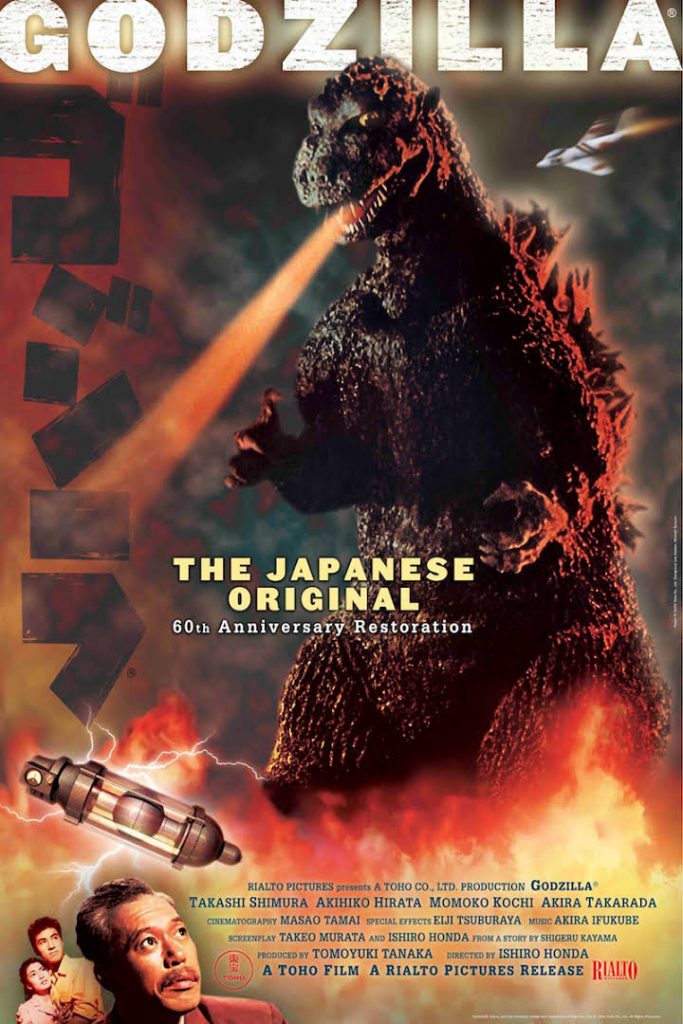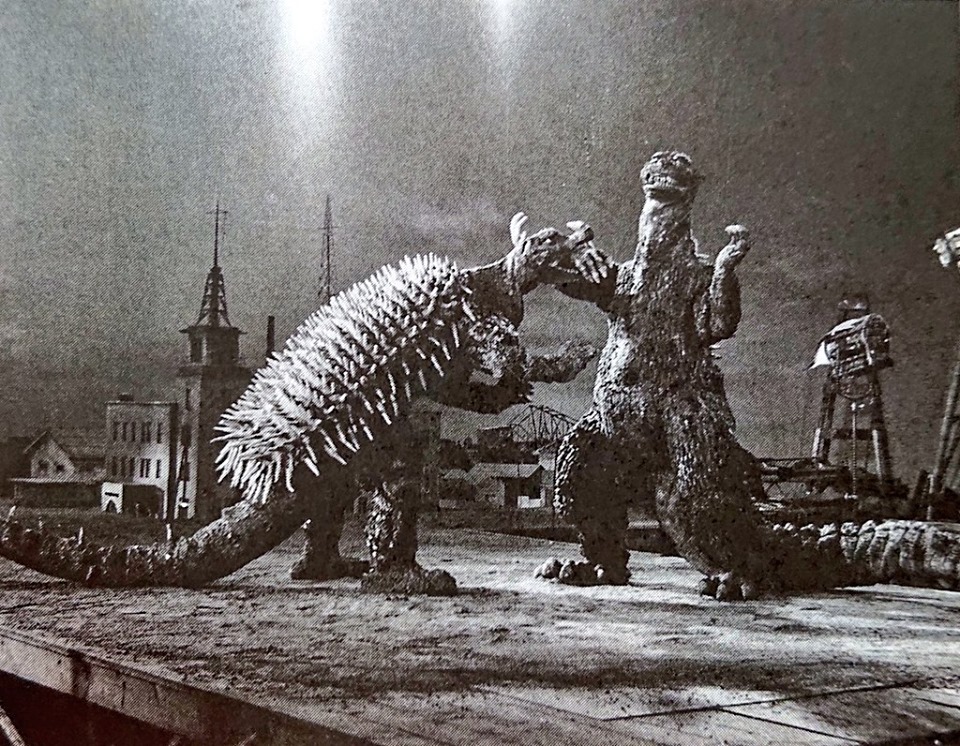When you think of dragons in Japanese pop culture, my first thought always goes to the slender, serpentine body type, like Haku, from one of our previous blogs. The saurian body morphology, I believe, is easily forgotten or neglected.
And yet, who doesn’t immediately know what I’m talking about, and can probably see him without even trying, when we mention the name Godzilla? We see a scaly giant looming high above a city skyline. He walks on hind legs, and sports a vicious row of spikes along his back, as well as some razor-sharp talons and chompers.
Am I right? Of course I am.
Strictly speaking, Godzilla is not considered a dragon. He is a kaiju. A large monster. However, he has many traits in common with dragons, the biggest one being his anatomy. Many dragons have a body resembling that of a dinosaur. And let’s not forget his atomic breath. While he doesn’t exactly breathe fire, his breath is so radioactive that it incinerates all manner of objects, from houses to cars to tanks and airplanes.
And while Godzilla doesn’t have the respectable age that the Jabberwock has, he can certainly rival the venerable poetry dragon when we look at the number of incarnations he’s undergone.
Furthermore, he has one characteristic that, to me, makes him fairly unique. While he may not have been the monster that led to the spawning of his genre–kaijū eiga or monster movies–he has certainly been the one to transcend it, traveling beyond the borders of his native Japan, and embedding himself into the collective memories of more than just the kaiju fans.
But let’s start with the beginning, shall we?
Godzilla (1954)

Because when I think of Godzilla, the first image that comes to mind is not the swanky CGI beastie trampling luscious realistic cities and cars in movies younger than I am. It’s a guy in a suit stomping around in a campy model city in the 1954 Godzilla.
If Wikipedia doesn’t lead me astray, special effects director Eiji Tsuburaya intended to use stop motion animation to bring Godzilla to life, but reluctantly settled for the suit we all remember fondly. I couldn’t find any mention of why, but it’s not unreasonable to assume that time was a large factor here.
Under his watchful eye, special effects art director Akira Watanabe and monster builder Teizo Toshimitsu based the design of Godzilla on dinosaurs. Most recognisable to me are the posture of the Tyranosaurus, and the dorsal plates of the Stegosaurus.
When it came to actually filming the monster scenes, the filmmakers used a technique called suitmation, a technique actually developed by Tsuburaya. Not only did suit actor Haruo Nakajima keep his movements slow and deliberate, but he was also filmed at a higher framerate to make him appear even slower.
Now, rather than a monster that is to be feared and destroyed, Japanese viewers apparently connected with the film on an emotional level, even seeing the monster as a victim of the hydrogen bomb tests that woke him up and left him in a world where he no longer has a place.
In a way, you could even see Godzilla as a metaphor for the atomic bomb that left the country scarred and traumatised, because, in the film, they are as defenseless against its rampage as they were in World War II when Hiroshima and Nagasaki were bombed. If Godzilla had been a mere dinosaur, they could have used military resources to dispatch the creature, but depth charges fail to kill him, and the electrified fence they construct to protect Tokyo is no match for his radioactive breath.
At the end of the film, after they finally succeed in destroying Godzilla, the paleontologist serving as an advisor to the officials tasked with handling this crisis, Dr. Kyohei Yamane, states that another Godzilla may awaken if nuclear weapons testing is not halted.
An American version was later created, stripped of the depth of political and cultural undertones present in the original.
Godzilla Raids Again (1955)

One year later, we see the return of our scaly, misunderstood friend. With a bigger budget, and a bit less of the commentary and characterisation that endeared the original to us, this movie still has a good bit to offer. Namely: a rivalling monster, called Anguirus.
Godzilla prevails, of course. Did you expect anything different?
Again, the military can’t seem to kill Godzilla, no matter what they throw at him. In the end, they trigger an avalanche and bury him in snow and ice.
King Kong vs. Godzilla (1962)
It takes a bit longer for the big guy to return this time. But he does it in style. Colourful style, to be precise.
With more action, more monster fights and a delicious level of kitsch and camp, this film is just plain good fun to watch. Or it could be, if one looked past the natives played by actors in blackface. Oh and let’s not forget the insane premise. Capture an unkillable, uncontrollable monster and use him as a marketing gimmick? Questionable in terms of both ethics and practicality, if you ask me.
Again, we have an Americanised version, with a different soundtrack, extra scenes, etc, to make it more palatable to US audiences, but I mean, I quite like the charm of original versions, if I can get them.
Godzilla vs. Mothra (1964)
OK. I see the trend going on here. Sequel number one: let’s get a second dinosaur to fight the first one. Sequel number two: another dinosaur? Nah, been there, done that. Let’s get King Kong! Yeah, that’s cool. Sequel number three: how about a flying monster this time? And no dinosaurs, guys. Enter Mothra.
Wait. A giant moth? That’s the scariest thing they could come up with? To the credit of the filmmakers, Mothra already had a movie, and a backstory, and a fan base. Something they would have had to build from scratch if they went with something more badass. However, Mothra does bring a new dynamic and choreography to the monster battles. And her wings are really pretty too.
Another improvement is the absence of black-face and much stronger characterisation.
Ghidorah, the Three-Headed Monster (1964)
Wait, what? The same year? Wow. Director Ishiro Honda was a busy bee. And such monsters, on such a tight schedule. Again according to our good buddies at Wikipedia, production was pushed forward so the film could fill up a gaping hole left on the roster when another movie, Red Beard suffered substantial delays in filming.
First of all: the enemy. Three heads? I’m already liking our friend Ghidorah. Although the friend is up for debate. You see, an alien from Venus possesses the body of a princess (the song She’s Got It is suddenly and inexplicably roaring through my head) in order to warn humanity. King Ghidorah is on his way, and Godzilla, Mothra, and Rodan are our only hope.
From enemy to saviour in less than a year. That’s how fast it can go, mythsters.
So on top of even more monsters–you could almost call it a monstravaganza–we now also have space travellers coming into the plot. But we also see the monsters taking a step back, and letting the human characters develop more. And then, in the final act, we have the battle extraordinaire.
Godzilla and Rodan at first refuse to join forces to save the pesky humans that have been picking on them for so long. I can’t say I blame them, to be honest. But once they see her going up against the wicked space dragon on her own, they decide to help her after all. In the end, they force the heavily outnumbered Ghidorah to run back wence he came from. Gone, but not dead. Perfect set-up for a sequel. Am I right?
Invasion of Astro-Monster (1965)
Bring on the space fiends! One mere year after pumping out not one but two Godzilla movies, Ishiro Honda is back with yet another one. Sadly, this film suffered some budget cuts when compared to its predecessor.
A bit of a fun twist: on top of big monsters or daikaiju, which Godzilla films have been known for up to this point, we now see an alien invasion coming on as well. And they’re sneaky buggers, too.
At first, they pull the victim card, asking for Earth’s permission to borrow Rodan and Godzilla to help them fight off our old friend Ghidorah. Hello? Borrow? Like a cup of sugar or a screwdriver? Without waiting for a reply, however, they come over and retrieve the creatures themselves, only to then set an ultimatum. Earth surrenders to their control, or they sic the three monsters on us, since they control the monsterminds.
OK, so, I’m not going to explain all of it, because time is short and we have a lot of ground to cover still. Suffice it to say the humans discover a spy among their ranks. Since she’s fallen in love with one of the humans, she gives away the secret to defeat the aliens and break the mind control of the monsters. Ghidorah flies off into space yet again, and Rodan and Godzilla topple off a cliff on the alien planet. Earth is safe. For now…
Ebirah, Horror of the Deep (1966)
The first in the Godzilla franchise not directed by Honda. But there were other changes in the staff department as well. Maybe people needed a change. Or a rest, after three movies in two years and number four following within a year.
Instead of the traditional city, where all previous films were set, this time, we head to a Pacific Island. We see Mothra making another appearance, as well as Roda–
No wait. That’s not Rodan. It’s The Giant Condor. But it could be his stunt double for all intents and purposes. The design department may have been lacking inspiration there… The costumes do look nice though. Lots of detail. And with Ebirah, we have another beastie coming from the sea. That has been a while.
Son of Godzilla (1967)
Aww, Godzilla made a baby. How sweet! And he’s called Minilla. That really is too precious. However, due to the stupidity of humans–who still haven’t clued in to the fact that atomic testing is not a good thing–already giant praying mantises grow even bigger, and that’s where the trouble starts.
Now, you get some adorable scenes where Godzilla teaches the kiddo all the things he needs to know–mostly roaring like a badass and using his itty bitty atomic ray–and then Minilla accidentally wakes up a giant spider (no it’s not Shelob, guys, sorry) while fighting off the mantises.
When it’s about to start munching on Minilla, Godzilla comes to the rescue, like any good dad, and kills the mantis.
Meanwhile, the scientists trapped on the island, in an amazing show of gratitude, tamper with the weather–way to go, humans–and turn the tropical island into an arctic pile of snow, forcing Godzilla and Minilla to go into hibernation. The end. But not really though.
Destroy All Monsters (1968)
Honda returns. And he’s brought some friends. Including our old buddy Anguirus from way back when. Of course, we still have the classic monsters, as well as some brand spanking new ones like Gorosaurus. But there’s one thing I cannot wrap my head around. Humans have apparently achieved world peace by 1999.
What is this, people? We’re way behind schedule. Chop chop!
Anyway. So world peace and all that. And the various kaiju have been confined to a place called Monsterland. Except we have another alien race mind-controlling them.
Déja-vu, anyone?
So, the monsters escape Monsterland and the aliens send them into cities to attack and trample and maim. But the humans wrestle control of the kaiju away from the aliens. Of course. That’s when the aliens bring in their wild card: Ghidorah. However, we’ve already firmly established that the space dragon is no match for the combined might of Godzilla and friends. So of course they prevail. Again.
While the fight scenes are awesome, the story is… predictable, to say the least. And it all sounds so familiar. Right?
All Monsters Attack (1969)
Another Ishiro Honda film, and number ten in the Godzilla franchise. A landmark number. This should be good.
Note that I say should. Because I can’t say I liked what parts I saw. Apparently, this film is famous–or infamous?–for being the worst one in the franchise.
The whole thing plays out in the dreams of a child. So, while that would explain the presence of strange, non-scary monsters like Mothra–because who else would come up with stuff like that, if not a bored and lonely kid–it’s a bit of a stretch to make nine movies before exposing the plot twist that it all just played out in the dreams of a child.
Furthermore, I’m left to wonder who did the montage. Because consistency in this film doesn’t appear to be a priority at all. In some shots, Minilla is as tall as the boy who does the dreaming, while in others, he’s monster-sized again, about half as tall as Godzilla.
In another strange twist of fate, the US version of the film was titled Godzilla’s Revenge, except there’s no revenge plot in the film, and Godzilla is barely in the picture.
Hmm, curiouser and curiouser.
Right. I’m sorry to go out on such a fizzle, mythsters, but I’m going to do it anyway. It seems fitting to pause here, as we’re about to step into a new decade of Godzilla, as well as a new name in the director’s seat.
Stay tuned for next week, and more kitschy Godzilla Goodness.
Later Mythsters!

Jasmine Arch
Jaz, also known as the Wolf Mother, is a writer, poet, narrator, and vessel of chaos. She is eternally grateful for her mother’s refusal to curtail her children in their choices–whether that was literature, spirituality, studies, or appearance–and grew up devouring her older brother’s collection of fantasy novels. In hindsight, telling stories of her own seems inevitable, but it took her a while to accept this and find the courage to begin.
Sources:
- https://en.wikipedia.org/wiki/Classic_of_Mountains_and_Seas
- https://filmmomaticreviews.wordpress.com/2019/06/13/all-my-godzilla-a-loving-retrospective/
- https://alchetron.com/Kaiju
- https://maserpatrol.wordpress.com/2017/01/08/%E6%80%AA%E7%8D%A3-or-%E5%A4%96%E7%8D%A3-kaiju-or-gaiju/
- https://en.wikipedia.org/wiki/Creature_suit#Kaiju_suits
- https://en.wikipedia.org/wiki/Godzilla#Appearances
- https://en.wikipedia.org/wiki/Godzilla_(1954_film)
- https://en.wikipedia.org/wiki/Invasion_of_Astro-Monster
- https://en.wikipedia.org/wiki/Ghidorah,_the_Three-Headed_Monster
- https://en.wikipedia.org/wiki/Son_of_Godzilla
- https://en.wikipedia.org/wiki/All_Monsters_Attack

Be First to Comment